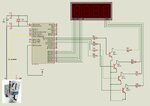riversky2k17
Newbie level 4
Hello everyone!!!
I have a project: COIN COUNTER using PIC16f877a.
I need help to get the output pulse of the coin to the T0CKI of the MCU and display the output on 4-digit 7 segment LED.
I already have idea on how to display the output on the 7 segment since I tested burning programs (like incrementing counter, led flashing) on the chip and got them work.
I programmed the coin acceptor (CH-926) to recognize 5 type of Philippine coin (10cents, 25cents, 1peso, 5peso, 10peso).
The coin acceptor (CH-926) provides varying pulse for each coin type of coin: (I checked using multimeter coz I dont have oscilloscope).
10cents=5pulses (change in voltage per second).
25cents=8pulses
1 peso=12pulses
5 peso=15pulses
10peso=18pulses
The range of voltage (DC) for the various types of coins is 2.68 to 4.29v. The voltage did not drop from 2.68 and did not go higher than 4.29v for each type of coin.
I am using a pic development board, mplab ide 4.05 + xc8 compiler, and proteus for simulation.
See attached image for my project setup.
I have a project: COIN COUNTER using PIC16f877a.
I need help to get the output pulse of the coin to the T0CKI of the MCU and display the output on 4-digit 7 segment LED.
I already have idea on how to display the output on the 7 segment since I tested burning programs (like incrementing counter, led flashing) on the chip and got them work.
I programmed the coin acceptor (CH-926) to recognize 5 type of Philippine coin (10cents, 25cents, 1peso, 5peso, 10peso).
The coin acceptor (CH-926) provides varying pulse for each coin type of coin: (I checked using multimeter coz I dont have oscilloscope).
10cents=5pulses (change in voltage per second).
25cents=8pulses
1 peso=12pulses
5 peso=15pulses
10peso=18pulses
The range of voltage (DC) for the various types of coins is 2.68 to 4.29v. The voltage did not drop from 2.68 and did not go higher than 4.29v for each type of coin.
I am using a pic development board, mplab ide 4.05 + xc8 compiler, and proteus for simulation.
See attached image for my project setup.
